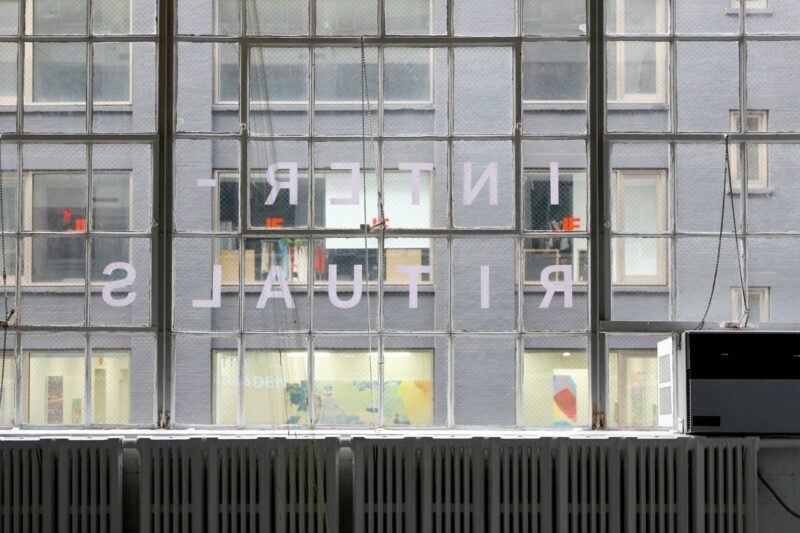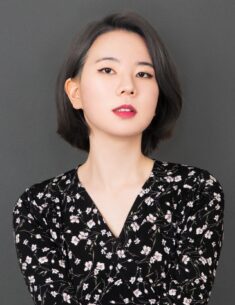On the 30th of March, the exhibition, “Inter-Rituals:
Between Materiality and Performances” took place at the Caelum Gallery
in Chelsea. Curated by Jin Wang,
Ph.D. student in Art History at the CUNY Graduate Center, the exhibition
featured works by three Chinese female artists working in the US, Kun Hong, Yin Zhang, and Yinglun Zhang. Hui Peng and Dohyun Gracia Shin,
both Ph.D. candidates in Theatre and Performance at the CUNY Graduate
Center, reviewed the three performances on the opening night of the
exhibition.
As the subtitle “Between Materiality and Performance” suggests, Inter-Rituals sophisticatedly married the art exhibition and a series of performances. The artists, all experienced in fashion, offer their unique perspective that “[stemmed] from the material background,” and their multimedia works addressed the subject of “rituals,” which is perceived within the framework of “the ephemeral performativity–whether it is spiritual, cultural or philosophical.” Audiences freely roamed around the exhibition space to interact with paintings, sculptures, installations, and films. Then, in the middle of the opening night, an open space surrounded by the exhibits became a space for performances. In the darkened atmosphere, audiences sat on the floor or stood to witness the performances, which were inspired from or part of their artworks displayed. In this sense, the open space in the Caelum Gallery transformed into a liminal space–where performers invited the audience rooted in the daily space into a realm of ritualistic performances conjured up by the collaboration of Kun Hong, Yin Zhang, and Yinglun Zhang.
“Untitled” by Kun Hong and Julia Santoli
The first performance, “Untitled,” heralded its start with a pure and resonant sound of a gold bell. One by one, four female performers entered the space, each carrying a long white string tassel symbolizing the process of ciba-making (糍粑, cí bā). “Untitled” is Kun Hong and Julia Santoli’s powerful tribute to the traditional Chinese ritual of ciba-making, a laborious process involving punching, kneading, and shaping rice into paste, usually carried out by women to commemorate special occasions and honor their ancestors. In this mesmerizing performance, Hong and Santoli brought to light the often-overlooked domestic labor of women throughout Chinese history. Hong's costume was characterized by the use of semiotics. “The more you punch,” said Hong in the after-show interview, “the rice becomes stickier and can be elastic to be a string, and that's where the invisible female labor lies.” In addition to the symbolic string tassel, the contrast between white and red held great symbolic significance. In “Untitled,” the performers were first wrapped in a bold red bodysuit that shrouded their head and torso, then in a white poncho festooned with red and white tassels. The semi-transparent white poncho, made of polyester chiffon, hinted at the veiled reality of blood, pain, and labor, while the red bodysuit, with its vividness and intensity, brought to light the invisible pain and labor in an implicit yet potent way.

In addition to the costume, chanting was another significant element of this piece, connecting the four contemporary performers with each other and their female ancestors. Developed from part-devised, part-improvised vocal workshops, chanting created a spontaneous vocal communication between and among performers as they traversed the exhibition space one after the other. “Chanting,” or in Santoli’s words, “vocal empowerment,” required immense trust of the performers. By delving into breathing exercises and honing their attentiveness to their corporeal selves, the performers gained an acute awareness of both their inner beings and external environments. They sank into space, into their bodies, and waited for an impulse to sound. Trust is a process that takes time to build, and so the space between sounds can be prolonged. It wasn’t until the very last of the performance when they finally engaged in a call-and-response interplay, amplifying, lowering, and echoing their voices to craft a rich and textured sonic terrain. Combined with the mingling sounds of the standing and sitting audience, the chanting created a sonic landscape for everyone who shared the time and space, lingering long after the last note had faded away.
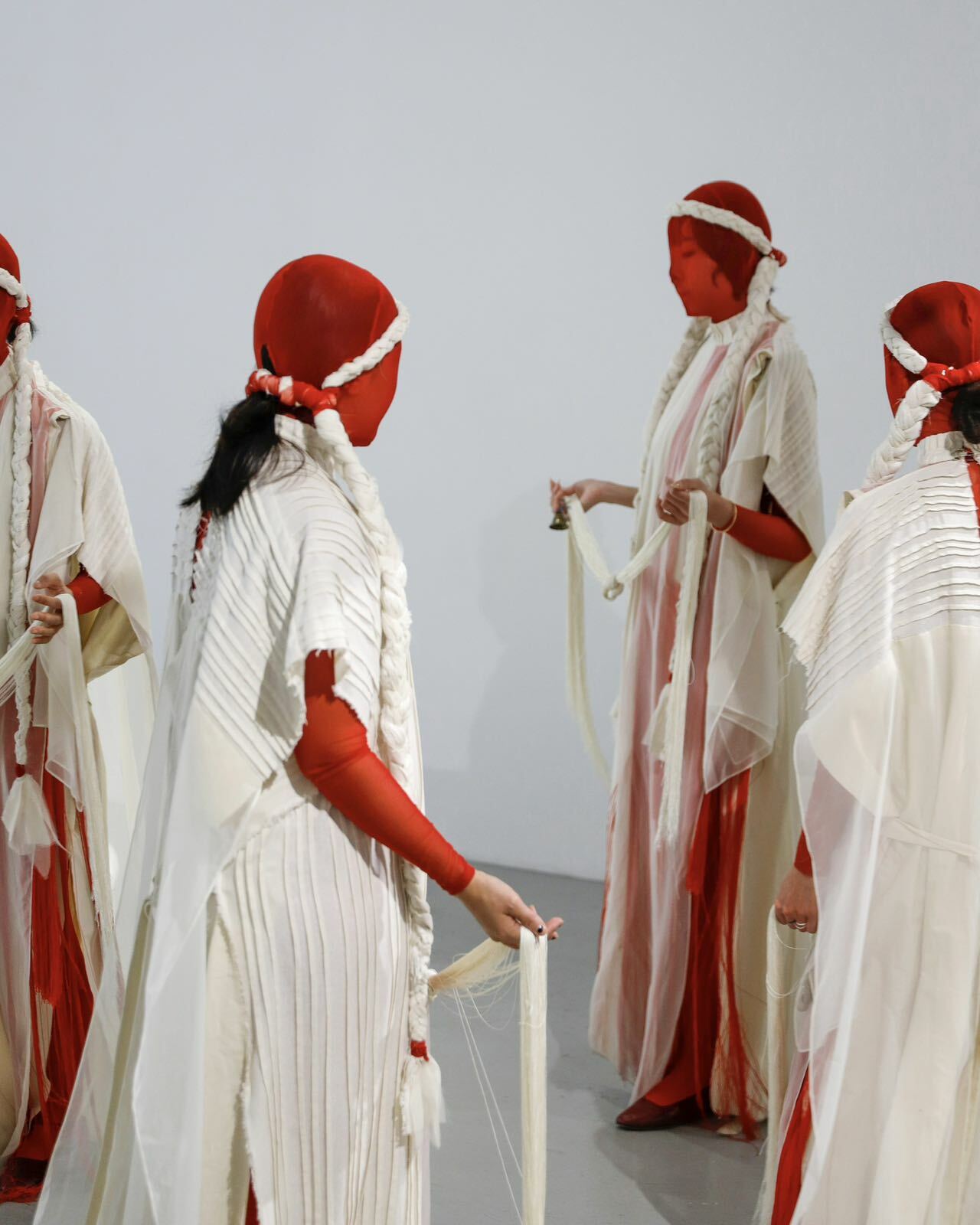
“Alaya-Vijnana” by Yin Zhang, performed by Caiyi Feng
After a brief technical rearrangement, Caiyi Feng walked into the spotlight and the second performance, “Alaya-Vijnana,” started. Feng was wearing an earthy-colored bodysuit, adorned with her fairly long, grey braid that entangled her neck and torso. Feng’s hair was styled with a big, white headpiece, evocative of the headdresses traditionally worn by the women of the ethnic Yao (瑶族, yáozú) in the Guangxi Province of China. Feng slowly danced to the agitating string melody accompanied by occasional ringing sounds. As the tension of the music escalated, Feng’s movement became dynamic, and soon, she stormed around among the audience. The performance ended next to the installation Chair, co-created by Zhang and Maggie Jiaxu Chang. Unfortunately, we did not have the privilege to see the second half of her performance from where we were sitting. Yet, her movement–which almost felt like a gale–was powerful enough to impress us with her performing presence.
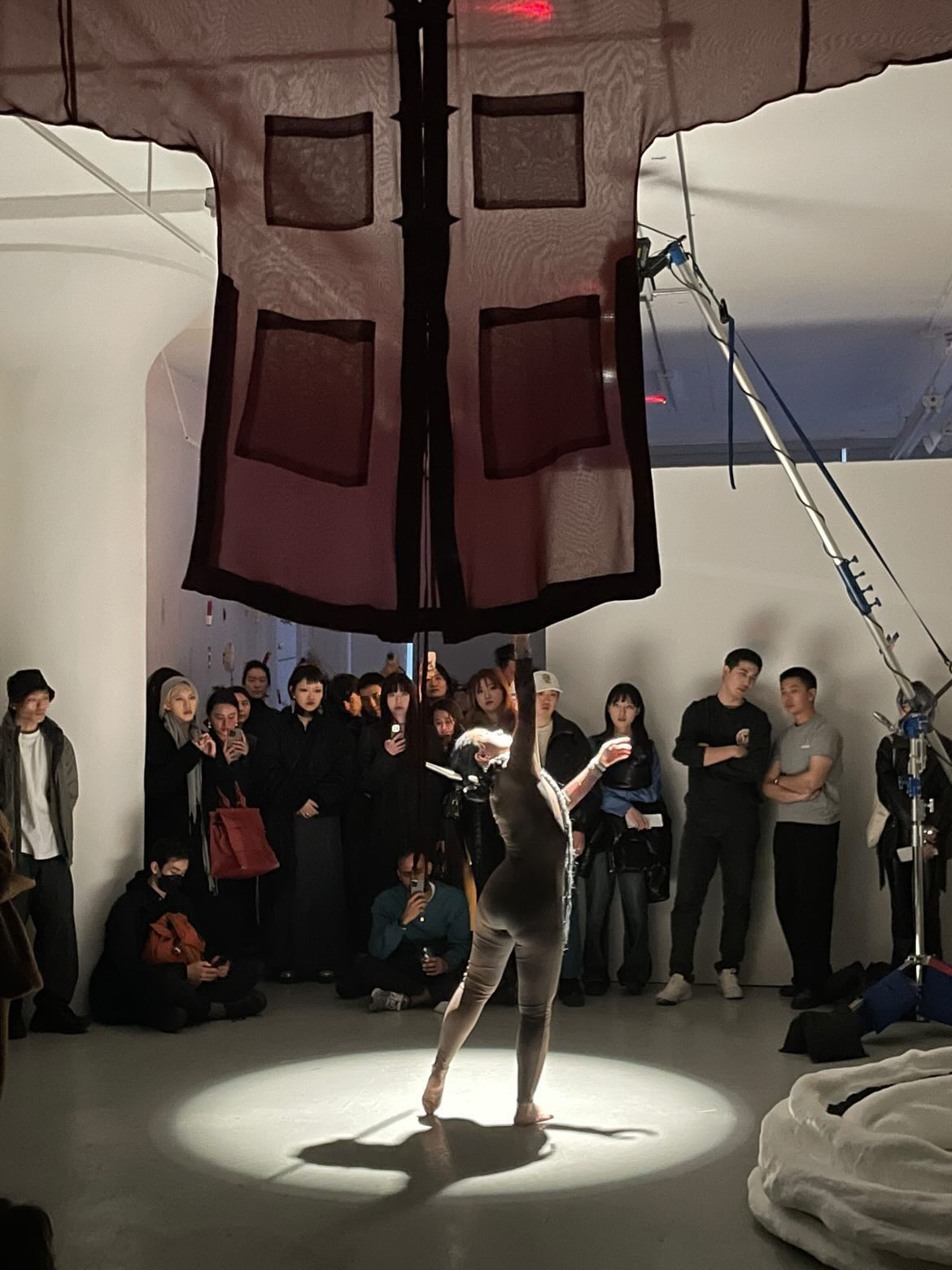
In the after-show interview with Zhang, it was revealed that in the latter half of the show, Feng made constant eye contact with the audience, almost as if to summon them to partake in her entrancing ritualistic act. Furthermore, we were informed that Feng danced as “the medium,” one of the characters in Zhang’s short film, “Unspooling Wind” (directed by Jessy Dong). In the film, “the medium” dances with the other three characters–who are half-human and half-kite. Their dance exquisitely represents Zhang’s insight of the kite’s liminal position straddling between humans and nature/sky. Zhang’s summoning of “the medium” to the Caelum Gallery did not fully unravel its artistic significance in relation to the film. Yet, as a medium, Feng invited the audience to experience the liminal moment where her ritualistic presence ephemerally filled the gallery and embraced the materiality of the exhibited artworks into the scenic atmosphere of her performance.

“From Zero to One to Null” by Yinglun Zhang, Junru Chen, Connie Jie-hung Shiau and Joe Fee
“From Zero to One to Null” delved into the intricacies of the relationship between the body, presence, and materiality. Co-choreographed by Yinglun Zhang and Connie Jie-hung Shiau, this piece created a memorable experience that drew from Zhang’s previous work, Meditation of Brushstrokes, during which she used her body to reenact Buddhist Li Shutong’s calligraphy through choreographic movements and rhythms.
The performer, Shiau, lay on the floor dressed in a silky ensemble of billowing water sleeves, paired with white pants and a blouse. At first glance, her body seemed to blend seamlessly with the silky costume. Suddenly, the sound of distant bells (music by Joe Fee) filled the air, and Shiau sprang to life, responding to the enchanting music with movements and gestures. In Zhang's artistic vision, the space created by the silky costume around the body serves as a transformative element that blurs the distinction between the body and materiality. The space allowed the costume to mimic the movements of muscles, as the material could create wrinkles and creases that replicated the folds and shapes of the human body in motion.

Serving as a backdrop was a large projection of dynamic geometrical shapes (designed by Junru Chen), which danced in perfect harmony with the music. Interestingly, the costume, music, and visual media were designed separately; however, they worked seamlessly in synchronization. This synchronicity allowed Zhang to delve deeper into the theme of presence, eternal return, and oneness. “Zhang's work cannot be understood separately,” said Wang in the after-show interview, “it's more like looking at a collection or series.” As audience members, we also received the invitation of synchronicity, immersing ourselves in the intricate and often indiscernible relationship between the dancer, materiality, music, visual media, and spatial arrangement, looking for ways to weave these threads to form our own narrative.
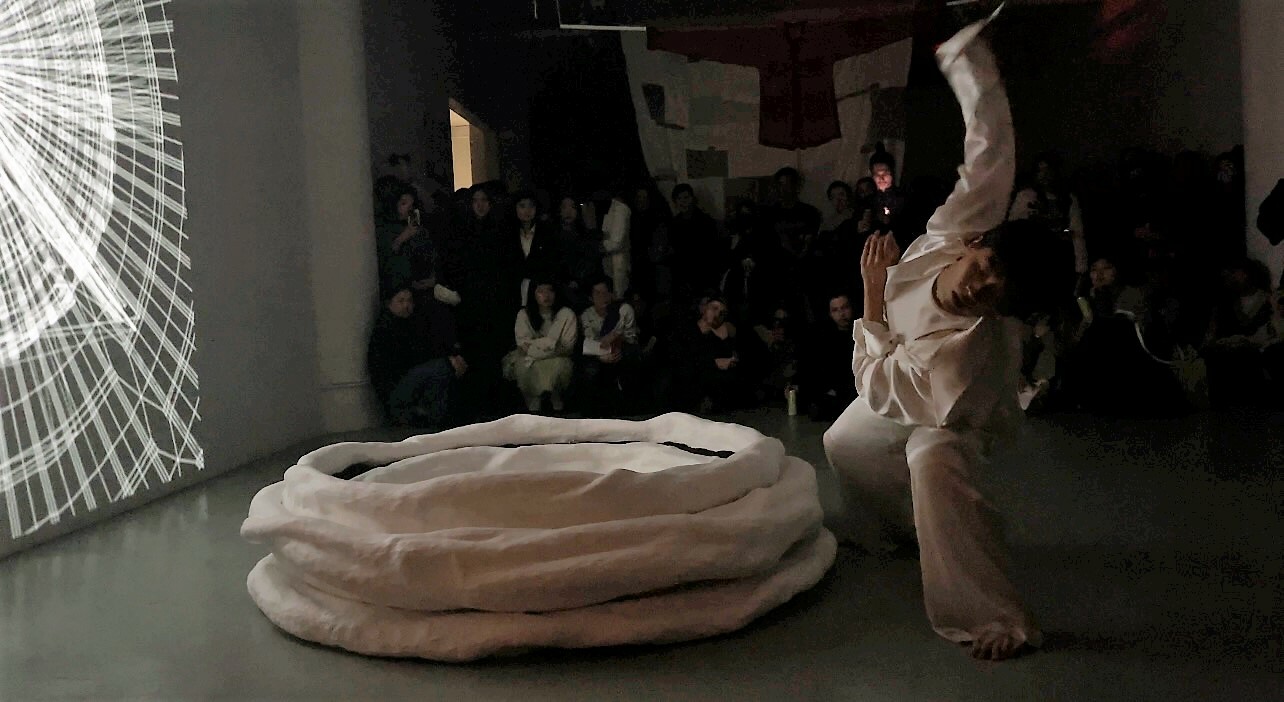
Wang used the term “pop-up” to describe the ephemeral nature of the three-day exhibition, a deliberate institutional critique of the ostentatious exhibition with deep pockets and lengthy runs. This innovative pop-up exhibition challenges the status quo by being both temporary and open to a wider audience through interdisciplinary curation. The three performances showcased on the opening night embraced the pop-up format, using the ephemeral nature of performance to amplify the impact of the critique. The ritualistic elements enriched the ephemerality of the performances by transmitting their meaning or meaning-making to the audience, who will continue to contemplate them in their daily lives long after the exhibition has ended.
- Hui Peng and Dohyun Gracia Shin, The CUNY Graduate Center
